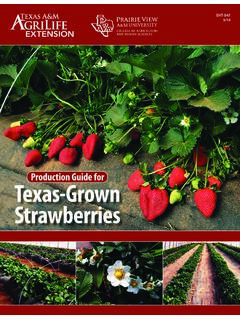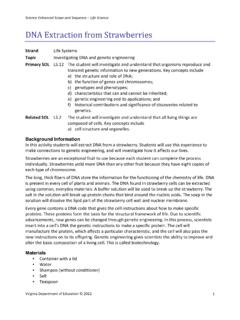Transcription of Nematode Management in Strawberries - UF/IFAS
1 ENY-031 Nematode Management in Strawberries1J. W. Noling21. This document is ENY-031 (NG031), one of a series of the Entomology & Nematology Department, Florida Cooperative Extension Service, Institute of Food and Agricultural Sciences, University of Florida. Published: March 1999. Revised: December 2009. For more publications related to horticulture/agriculture, please visit the EDIS Web site at 2. J. W. Noling, professor, Entomology and Nematology Department, Citrus Research and Education Center, Cooperative Extension Service, Institute of Food and Agricultural Sciences, University of Florida, Lake Alfred, FL Institute of Food and Agricultural Sciences (IFAS) is an Equal Opportunity Institution authorized to provide research, educational information and other services only to individuals and institutions that function with non-discrimination with respect to race, creed, color, religion, age, disability, sex, sexual orientation, marital status, national origin, political opinions or affiliations.
2 Department of Agriculture, Cooperative Extension Service, University of Florida, IFAS, Florida A. & M. University Cooperative Extension Program, and Boards of County Commissioners Cooperating. Millie Ferrer-Chancy, Interim Dean The sting Nematode , Belonolaimus longicaudatus, is a pest of major importance to commercial strawberry production in Florida. Although the disease was first noticed in strawberry in 1946, it was not until 1950 that the problem was correctly identified as that of the sting Nematode . The increasing importance of sting Nematode on strawberry in central Florida was observed to coincide with a decrease in the use of velvet bean as a summer cover crop and an increase in the use of sesbania. During World War II, many strawberry fields which were not cover cropped, were more or less neglected and allowed to revert to native weed cover during the summer off-season. It was then observed that the extent to which a fall-planted strawberry crop was injured by sting Nematode was strongly influenced by the kind of vegetation that was allowed to grow within the field during the preceding summer.
3 The effect was so pronounced in fact, that spots of severely stunted plants could be directly related to the different, but specific, weed plants within the field during summer. A large majority of this natural weed growth was reported as crabgrass, an excellent host for sting Nematode (Figure 1). Figure 1. The establishment of crabgrass (Digitaria spp.) in a cover cropped field of hairy indigo (Indigo hirsuta).Since the 1950's, B. longicaudatus has subsequently become recognized as one of the most economically important Nematode crop pests in the southeastern United States, and the primary Nematode parasite on strawberry in Florida. The introduction of irrigation into Florida agriculture is thought to have substantially increased cropping problems due to this Nematode , especially in strawberry production. Based on evidence from other crops, parasitism by B. longicaudatus has also been shown to interact with other soilborne pests, causing a greater incidence and severity of certain fungal diseases, most notably Fusarium and Management in Strawberries2 The sting Nematode appears to be a native pest of the sandy soils of the lower Coastal Plains of the southeastern United States.
4 It has such a preference for sandy soils, that it fails to exist in significant numbers in soils containing even small amounts of silt, clay, or organic matter content. Sting Nematode reproduction is greatest in sandy soil, at temperatures of 75-85 F (25-30 C) with constant, but moderate, moisture levels. Under suitable conditions, a life cycle is completed in about 28 days. The higher numbers and greater distribution of sting Nematode in Florida is probably not only related to the predominance of fine sandy soil but also due to the warm subtropical environment. In addition, sting Nematode appears to be very sensitive to sudden changes in soil conditions such as rapid production problems caused by sting Nematode tend to occur in more or less definite areas where transplants fail to grow-off normally (Figure 2). Infested areas consist of spots that vary in size and shape, but the boundary between diseased and healthy plants usually is fairly well defined. Initially a field may have only a few such areas, which may then increase in size and number until the entire field becomes involved.
5 The effect on Strawberries is to cause both stunting and decline, the intensity of which is related to initial population level and the rates to which populations increase during the course of strawberry crop growth. Affected plants become semi-dormant, with little or no new growth. Leaf edges turn brown, progressing or expanding from the edges to midrib to include the entire leaf. Leaves seldom become chlorotic, although cases have been reported in which leaf yellowing occurs when essential nutrients are present in limited supply. Since the outer older leaves die first the plant gradually decreases in size and eventually may be killed (Figure 3). Figure 2. Strawberry plant stunting caused by the sting (Belonolaimus longicaudatus). Note irregular or patchy field distribution of stunted plants rather than throughout the entire 3. Progressive decline of strawberry due to sting Nematode , Belonolaimus longicaudatus. Note death of leaves from outside in towards the crown (oldest to youngest leaves).
6 Sting Nematode can be very damaging to nursery seedlings and transplants. As a general rule, most other crop plants are not killed unless subjected to other adverse conditions but affected strawberry plants undergo progressive decline and may eventually die. Older plants that have already developed an extensive root system can still be severely affected. Under field conditions in Florida, instances are common where sting nematodes have caused only minor root system damage in the upper 3 to 4 inches of soil. In this soil zone, plants can develop a dense root system but no roots are able to penetrate below this upper layer (Figure 4). Such plants can be easily lifted or pulled from soil and are much more susceptible to droughty conditions and injury from fertilizer salt growth abnormalities are caused, in part, by injury inflicted at the root tips, which results in little or no new root growth, plants lacking in fine feeder roots, and the development of short stubby branches. Root tips are killed, forcing the development of new lateral roots, whose root tips in turn are killed.
7 This results in the production of a root system consisting of coarse roots with knobby tips. In addition, necrotic lesions may also be produced laterally along the sides of roots. Since sting Nematode does not feed Nematode Management in Strawberries3 Figure 4. Sting Nematode , Belonolaimus longicaudatus, induced symptoms on strawberry roots. Note short, dark and discolored abbreviated roots with swollen root , the usual microscopic examination of diseased roots does not aid diagnosis since no organism is present within roots. Positive confirmation of sting Nematode can only be made by soil OrganismThe original description of the genus Belonolaimus, the type species B. gracilis, and the common name 'sting' Nematode was given by Steiner in 1949. Much of the early published research works in Florida Strawberries reported involvement by B. gracilis. Unfortunately, only the species B. longicaudatus, described by Rau in 1958, has been reported to cause serious injury to a wide array of economically important crops, including Strawberries , within the southeastern United States.
8 Because Steiner's B. gracilis has not been observed since the original description, except for one unrecorded observation, the sting Nematode associated with strawberry is now generally regarded exclusively to be that of B. , the sting Nematode is identified by its unusually long, slender body (2mm) and stylet (generally in excess of 100um). Both males and females are generally numerous within the population. Females possess two ovaries, esophagus and overlapping glands, and males are characterized by long, pointed tails, with well developed burse. A number of physiological races have been observed based on differences in morphology and host ranges between geographic populations of sting Diagnosis & SamplingBecause of their microscopic size and irregular field distribution, soil and root tissue samples are usually required to determine whether sting nematodes are causing poor crop growth or to determine the need for Nematode Management . For sting nematodes, sampling and Management is a preplant or postharvest consideration because if a problem develops in a newly planted crop there are currently no postplant corrective measures available to rectify the problem completely once the Nematode becomes established.
9 Nematode density and distribution within a field must therefore be accurately determined before planting, guaranteeing that a representative sample is collected from the field. Advisory or Predictive Sample (Prior to Planting)Samples taken to predict the risk of sting Nematode injury to a newly planted strawberry crop must be taken well in advance of planting to allow for sample analysis and treatment periods if so required. For best results, sample for nematodes at the end of the growing season, before crop destruction, when nematodes are most numerous and easiest to detect. Collect soil and root samples form 10-20 locations within the field using a cylindrical sampling tube, or if unavailable, a trowel or shovel (Figure 5). Since sting nematodes are concentrated in the crop rooting zone, samples should be collected to a soil depth of 6-10 inches. Sample in a regular pattern over the area, emphasizing removal of samples across rows rather than along rows (Figure 6). One sample should represent no more than 5 acres for such a high value crop as Strawberries .
10 Fields which have had different crops during the past season or which have obvious differences either in soil type or previous history of cropping problems should be sampled separately. Sample only when soil moisture is appropriate for working the field, avoiding extremely dry or wet soil Management in Strawberries4 Figure 5. The collection of soil samples for Nematode analysis can be acquired from the field using either cylindrical sampling tubes, trowels, bucket auger, or 6. Suggested pattern for collecting preplant soil samples for Nematode analysis based on compositing soil from 10-20 field diagnostic purposes on established plants, roots and soil cores should be removed to a depth of 6-10 inches from 10-20 suspect plants. Avoid dead or dying plants, since dead or decomposing roots will often harbor few nematodes. For seedlings or young transplants, excavation of individual plants may be required to insure sufficient quantities of infested roots and soil. Submission of additional samples from adjacent areas of good growth should also be considered for comparative purposes (Figure 7).









